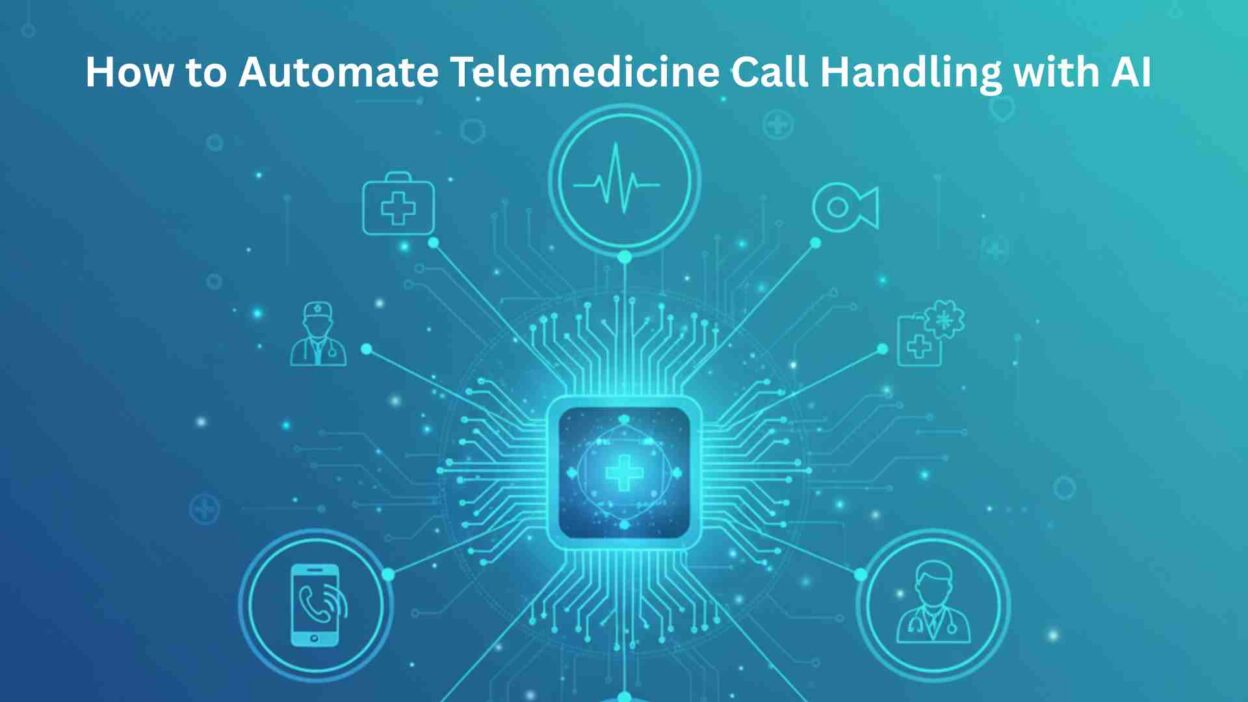Introduction to AI-Powered Telemedicine Communications
TL;DR Healthcare delivery has transformed dramatically through telemedicine adoption in recent years. Patient calls flood medical practices seeking appointments, information, and urgent guidance. AI for telemedicine call handling revolutionizes how healthcare providers manage increasing communication volumes efficiently.
Table of Contents
Traditional phone systems struggle under the weight of modern patient expectations. Long hold times frustrate patients, while staff members feel overwhelmed constantly. Intelligent automation addresses these challenges without sacrificing care quality or personal touch.
Medical practices implementing AI call solutions report significant improvements in operations. Staff productivity increases while patient satisfaction scores rise simultaneously. This guide explores practical strategies for automating telemedicine communications effectively.
Understanding Telemedicine Call Challenges
Volume and Capacity Limitations
Medical practices receive hundreds or thousands of calls daily seeking various services. Appointment scheduling, prescription refills, test results, and triage requests all come through phone lines. Limited staff cannot possibly answer every call promptly during peak hours.
Missed calls translate directly to lost revenue and dissatisfied patients. Prospective patients calling for first appointments often choose competitors who answer faster. Existing patients grow frustrated when they cannot reach providers consistently.
Staff burnout increases when team members face relentless call queues without relief. Turnover rises as employees seek less stressful work environments elsewhere. High turnover creates additional costs through constant recruiting and training.
Complex Routing Requirements
Different call types require routing to appropriate departments and specialists. Billing questions go to finance, while medical inquiries need clinical staff. Incorrect routing wastes time for both patients and employees.
Emergencies demand immediate recognition and priority handling. Life-threatening symptoms cannot wait in standard queues behind routine calls. AI for telemedicine call handling identifies urgency automatically through conversation analysis.
After-hours coverage creates additional complexity requiring on-call coordination. Determining who handles which calls when offices close requires systematic logic. Manual coverage management frequently results in confused patients and missed communications.
Compliance and Documentation Needs
HIPAA regulations require strict protections for patient information during all communications. Recording, storage, and access controls must meet federal standards. Violations carry severe penalties, including substantial fines and legal consequences.
Complete documentation of patient interactions supports continuity of care. Accurate records ensure providers have the necessary context for treatment decisions. Manual note-taking during calls introduces errors and omissions regularly.
Quality assurance monitoring ensures staff follow proper protocols consistently. Reviewing recorded calls identifies training needs and compliance gaps. Manual quality review processes cannot possibly cover all patient interactions.
Language and Accessibility Barriers
Diverse patient populations speak dozens of different languages, requiring translation services. Live interpreters add costs and delays to simple interactions. Language barriers prevent many patients from accessing needed healthcare effectively.
Hearing-impaired patients require alternative communication methods beyond voice calls. TTY services and text-based options must be available. Accessibility compliance ensures equal access for all patient populations.
AI for telemedicine call handling breaks down language barriers through real-time translation. Patients communicate in their preferred language without waiting for interpreters. Accessibility improves dramatically through automated multilingual support.
Benefits of AI Call Automation in Healthcare
Improved Patient Access and Satisfaction
Twenty-four-hour availability means patients reach help whenever they need it. No more waiting until business hours to ask important questions. Around-the-clock service dramatically improves patient experiences and outcomes.
Reduced wait times eliminate frustration from long hold periods. Patients get immediate responses to routine inquiries without delays. Faster service increases satisfaction scores across all patient demographics.
Consistent service quality ensures every patient receives excellent treatment. AI systems never have bad days that affect their performance negatively. Reliability builds trust and strengthens patient-provider relationships over time.
Enhanced Staff Productivity
Automation handles repetitive inquiries, freeing staff for complex patient needs. Scheduling, directions, and basic information requests processed automatically. Clinical staff focus on activities requiring human expertise and judgment.
Call volume reductions decrease workplace stress significantly for healthcare teams. Staff morale improves when employees feel capable of managing workloads. Better work environments reduce turnover, saving recruitment and training expenses.
AI for telemedicine call handling provides staff with comprehensive context before patient interactions. Automated systems gather preliminary information that humans previously collected manually. Prepared staff resolve issues faster with better outcomes.
Cost Reduction and Efficiency Gains
Lower staffing requirements reduce the largest expense category in call centers. Fewer employees handle the same call volume through automation assistance. Labor cost savings justify technology investments within months, typically.
Increased appointment utilization improves revenue through better scheduling efficiency. AI systems optimize calendar management, reducing empty appointment slots. Fuller schedules generate more revenue without adding provider hours.
Reduced no-show rates result from automated reminders and confirmation systems. Patients receive multiple touchpoints before appointment,s decreasing forgetfulness. Fewer missed appointments maximize provider productivity and clinic revenue.
Better Clinical Outcomes
Accurate symptom collection ensures appropriate triage decisions. Standardized protocols guide patients to the correct care levels consistently. Proper triage prevents both under-treatment and unnecessary emergency visits.
Medication adherence improves through automated follow-up and reminder systems. Patients taking medications correctly achieve better health outcomes. Improved adherence reduces complications and hospitalizations significantly.
AI for telemedicine call handling identifies high-risk patients requiring proactive outreach. Early intervention prevents health deterioration and costly emergency care. Predictive analytics enable preventive medicine at the population scale.
Core Components of AI Call Systems
Natural Language Processing
Speech recognition converts patient voices into text for analysis. Modern systems understand medical terminology and diverse accents accurately. High accuracy ensures patients don’t need to repeat themselves frustratingly.
Intent recognition determines what patients want from their calls. Appointment requests, prescription questions, and symptom descriptions all trigger different responses. Accurate intent classification routes patients correctly from initial contact.
Entity extraction identifies specific information like dates, medications, and symptoms. Structured data from conversations populates medical records automatically. This capability eliminates manual data entry, reducing errors significantly.
Intelligent Call Routing
Skills-based routing matches patient needs with appropriate staff expertise. Cardiology questions reach cardiac nurses while pediatric concerns route to child specialists. Specialized routing improves resolution rates and patient satisfaction.
Priority queuing ensures urgent situations receive immediate attention. Chest pain descriptions trigger emergency protocols automatically. AI for telemedicine call handling recognizes life-threatening situations requiring instant response.
Workload balancing distributes calls evenly across available staff members. No single employee becomes overwhelmed while others sit idle. Fair distribution improves both efficiency and employee satisfaction.
Conversational AI Assistants
Virtual assistants handle complete interactions for routine inquiries. Patients schedule appointments, request refills, and get information without human involvement. Automation percentage increases as systems learn more scenarios.
Multi-turn conversations feel natural rather than robotic or rigid. Patients express themselves freely while AI understands context and nuance. Conversational quality determines patient acceptance and system success.
Personality and tone matching ensure AI interactions feel appropriately professional. Healthcare communications require empathy and compassion beyond transactional exchanges. Well-designed assistants balance efficiency with human warmth.
Integration Capabilities
Electronic health record connectivity enables personalized interactions based on patient history. AI systems access medication lists, appointment history, and treatment plans. Contextual awareness makes conversations more relevant and efficient.
Practice management system integration coordinates scheduling across providers and locations. Real-time calendar access prevents double-booking and conflicts. Seamless integration eliminates manual coordination, reducing errors.
AI for telemedicine call handling connects with insurance verification systems. Coverage confirmation happens automatically during scheduling interactions. Patients know their financial obligations before appointments, reducing billing surprises.
Implementation Steps for Healthcare Practices
Assessing Your Current Call Operations
Document existing call volumes by time of day and day of week. Understanding patterns informs staffing decisions and automation priorities. Peak period identification helps optimize both technology and human resources.
Categorize call types to identify automation opportunities. Simple inquiries are automated more easily than complex clinical consultations. Starting with high-volume routine calls delivers quick wins, building implementation momentum.
Measure current performance metrics, establishing a baseline for improvement measurement. Average wait time, abandonment rate, and patient satisfaction scores all matter. Clear baselines prove ROI after AI implementation completes.
Defining Your Automation Strategy
Prioritize use cases based on volume, complexity, and patient impact. Not every call type needs automation immediately from day one. Strategic phasing delivers results while managing change effectively.
Determine which interactions require human involvement versus full automation. Emergencies always need human clinicians despite technology capabilities. Clear escalation criteria protect patient safety throughout automation.
AI for telemedicine call handling works best with well-defined protocols and workflows. Document current processes before automating them systematically. Process clarity enables effective translation into automated systems.
Selecting the Right AI Platform
Evaluate vendors based on healthcare-specific experience and compliance credentials. Generic call center solutions lack the necessary medical features and understanding. Healthcare-focused platforms include HIPAA compliance and clinical workflows.
Request demonstrations with scenarios matching your specific practice needs. Generic demos don’t reveal how systems handle your unique requirements. Custom demonstrations validate vendor claims with realistic examples.
Check references from similar practices regarding implementation and ongoing support. Other healthcare providers provide honest assessments beyond vendor marketing. Learning from others’ experiences prevents costly mistakes.
Planning Your Integration Architecture
Map data flows between AI systems and existing healthcare technology. EHR, practice management, and billing systems all need connectivity. Comprehensive integration planning prevents functionality gaps after launch.
Address security requirements through proper network architecture and access controls. Patient data protection cannot be compromised for convenience. Security-first design prevents compliance violations and data breaches.
AI for telemedicine call handling requires high availability and disaster recovery planning. Healthcare communications cannot tolerate extended outages during emergencies. Redundancy and backup systems ensure continuous operation.
Training Staff and Patients
Comprehensive staff training covers both system operation and process changes. Employees need technical skills and an understanding of new workflows. Confident staff members drive successful adoption and utilization.
Change management addresses concerns and resistance to automation. Some staff fear technology will eliminate their jobs. Clear communication about augmentation versus replacement reduces anxiety.
Patient education explains new options and sets appropriate expectations. Gradual introduction allows time for patients to adapt comfortably. Communication campaigns promote benefits while addressing concerns proactively.
Key Features for Telemedicine Call Automation
Automated Appointment Scheduling
Self-service scheduling empowers patients to book appointments at their convenience. No more phone tag with office staff during business hours only. Twenty-four-seven availability increases appointment bookings significantly.
Calendar optimization algorithms find the best available slots matching patient preferences. Location, provider, and time preferences all factor into suggestions. Intelligent scheduling maximizes both patient satisfaction and practice efficiency.
Automated confirmations and reminders reduce no-show rates dramatically. Multiple touchpoints through text, email, and voice reach patients effectively. AI for telemedicine call handling prevents revenue loss from missed appointments.
Prescription Refill Management
Automated refill requests route to appropriate pharmacy workflows. Patients request refills conversationally without navigating complex menu systems. Simple processes increase patient adherence to medication regimens.
Verification checks ensure refill requests are appropriate and timely. Systems flag early refill attempts, indicating possible misuse. Safety protocols protect patients and comply with controlled substance regulations.
Integration with e-prescribing systems completes the automated workflow. Approved refills transmit directly to patient-preferred pharmacies automatically. Seamless processes improve patient experiences while reducing staff workload.
Symptom Assessment and Triage
Guided symptom collection follows evidence-based clinical protocols. Patients answer structured questions determining severity and urgency. Consistent assessment ensures appropriate care level recommendations.
Risk stratification identifies patients needing immediate emergency care. Life-threatening symptoms trigger alerts to clinical staff instantly. AI for telemedicine call handling never misses critical situations requiring urgent attention.
Care recommendations guide patients to appropriate resources efficiently. Emergency department, urgent care, office visit, or self-care options all depend on assessment. Proper triage reduces unnecessary emergency visits while ensuring safety.
Insurance Verification and Benefits Checking
Automated eligibility verification confirms coverage before appointment scheduling. Real-time checks with insurance companies provide instant answers. Patients know their coverage status, eliminating billing surprises later.
Benefits explanation helps patients understand their financial obligations. Copay amounts, deductibles, and coverage limitations all communicate clearly. Financial transparency improves patient satisfaction and collection rates.
Pre-authorization management automates the complex approval process. Required authorizations are submitted automatically when scheduling certain procedures. Automation prevents appointment delays from missing authorizations.
Medical Records Request Handling
Automated systems guide patients through medical records request processes. Required forms and identification verification happen systematically. Streamlined processes reduce turnaround times for patient requests.
HIPAA-compliant authentication ensures that only authorized individuals access records. Security measures protect patient privacy throughout the process. AI for telemedicine call handling maintains compliance while improving efficiency.
Electronic delivery options provide immediate access to requested records. Patients receive documents through secure portals without waiting for the mail. Digital delivery reduces costs while improving patient convenience.
Ensuring Compliance and Security
HIPAA Requirements for AI Systems
Protected health information requires encryption in transit and at rest. AI platforms must meet federal security standards rigorously. Compliance is non-negotiable in healthcare technology implementations.
Access controls limit system access to authorized personnel only. Audit trails track who accessed what information when. Accountability measures support compliance and detect potential breaches.
Business associate agreements formally establish vendor compliance obligations. All AI platform providers must sign BAAs covering their responsibilities. Legal protections safeguard practices from vendor-caused violations.
Quality Assurance Protocols
Regular monitoring ensures AI systems perform accurately and safely. Clinical protocols require validation through ongoing quality checks. Patient safety depends on systematic quality assurance processes.
Error detection mechanisms identify system failures requiring immediate attention. AI for telemedicine call handling includes fail-safes preventing harm from mistakes. Safety-first design protects patients when technology encounters edge cases.
Continuous improvement processes refine AI performance over time. Feedback loops from staff and patients identify enhancement opportunities. Iterative refinement keeps systems current with evolving needs.
Emergency Escalation Procedures
Clear protocols define when AI systems must transfer to humans immediately. Life-threatening situations always require human clinical judgment. Escalation speed determines outcomes in critical scenarios.
Backup communication channels ensure connectivity during system failures. Technical problems cannot prevent patients from reaching emergency help. Redundant systems protect patients during technology outages.
Staff training on override procedures empowers employees to intervene. Humans must be able to take control of automated systems instantly. Override capabilities balance automation with human oversight.
Measuring Success and ROI
Key Performance Indicators
Call answer rates measure how many patients connect successfully. High answer rates indicate adequate system capacity and performance. Abandoned calls represent lost opportunities and frustrated patients.
Average wait time quantifies patient experience during call handling. Shorter waits correlate strongly with higher satisfaction scores. AI for telemedicine call handling dramatically reduces wait times compared to traditional systems.
First-call resolution rates show how effectively systems address patient needs. Multiple contacts for the same issue frustrate patients and waste resources. High resolution rates demonstrate automation effectiveness.
Patient Satisfaction Metrics
Survey scores directly measure patient perception of call experiences. Post-interaction surveys capture immediate feedback on service quality. Consistent measurement tracks improvements over time objectively.
Net Promoter Score indicates the likelihood that patients will recommend the practice. High NPS scores reflect superior patient experiences, driving referrals. Patient loyalty grows when communication meets or exceeds expectations.
Complaint rates reveal problems requiring attention and correction. Decreasing complaints validate that automation improves rather than harms experiences. Trend analysis identifies systemic issues needing resolution.
Operational Efficiency Measures
Cost per call calculation demonstrates the financial impact of automation. Comparing automated versus human-handled call costs proves ROI. Significant savings justify technology investments to financial stakeholders.
Staff productivity metrics show how automation affects employee output. Calls handled per staff member should increase after implementation. Higher productivity means the same team accomplishes more work.
AI for telemedicine call handling enables appointment capacity increases without adding providers. Fuller schedules generate more revenue from existing resources. Revenue growth from better utilization demonstrates tangible business value.
Clinical Outcome Tracking
Triage accuracy measures whether patients receive appropriate care recommendations. Validated outcomes confirm that automated assessment performs safely. Clinical effectiveness is paramount in healthcare automation.
Preventable emergency visits decrease when triage directs patients appropriately. Fewer unnecessary ER visits reduce costs for patients and payers. Improved care navigation benefits all healthcare system stakeholders.
Chronic disease management outcomes improve through automated outreach and monitoring. Regular contact helps patients stay on track with treatment plans. Technology-enabled care coordination produces better health results.
Advanced Capabilities and Future Innovations
Predictive Analytics for Proactive Care
Risk prediction models identify patients likely to experience health deterioration. High-risk individuals receive proactive outreach to prevent emergencies. Predictive medicine shifts healthcare from reactive to preventive.
Appointment no-show prediction enables targeted reminder campaigns. Extra outreach to likely no-shows reduces wasted appointment slots. Predictive intervention optimizes schedule utilization and revenue.
AI for telemedicine call handling will increasingly anticipate patient needs before explicit requests. Refill reminders, screening recommendations, and follow-up prompts all deploy automatically. Proactive communication improves both outcomes and satisfaction.
Voice Biometric Authentication
Speaker recognition provides secure patient authentication without passwords. Unique voiceprints verify identity during phone interactions. Biometric security enhances protection while improving convenience.
Continuous authentication monitors for voice changes indicating someone else. Mid-call verification ensures the authorized patient remains on the line. Advanced security protects information throughout the entire interaction.
Privacy-preserving biometric technology complies with regulations while enabling functionality. Proper implementation balances security with patient privacy rights. Ethical considerations guide biometric feature deployment in healthcare.
Multilingual Support Expansion
Real-time translation enables service in hundreds of languages simultaneously. Patients communicate in preferred languages without waiting for interpreters. Universal access breaks down language barriers to healthcare.
Cultural adaptation goes beyond translation to respect communication norms. Different cultures have varying expectations for medical discussions. AI for telemedicine call handling adapts appropriately to cultural contexts.
Dialect and accent recognition improve understanding of diverse speakers. Regional variations within languages require sophisticated processing. Inclusive design ensures equitable access for all populations.
Integration with Wearable Devices
Connected health devices will feed data directly into AI call systems. Blood pressure, glucose, and activity information inform conversations automatically. Device integration enables more personalized and informed interactions.
Automated alerts based on device data trigger proactive outreach. Abnormal readings prompt immediate contact, ensuring appropriate response. Technology integration enables continuous remote monitoring at scale.
Patient-generated health data enriches clinical context during interactions. Complete information improves decision quality for both AI and human providers. Comprehensive data access transforms telemedicine capabilities significantly.
Best Practices for Successful Implementation
Start with High-Volume Simple Use Cases
Appointment scheduling and basic information requests are automated. Early successes build confidence and demonstrate value quickly. Starting small manages risk while proving the concept effectively.
Gradually expand automation to more complex scenarios over time. Rushing into difficult use cases increases failure risk unnecessarily. Measured progression delivers sustainable long-term success.
AI for telemedicine call handling improves through experience and data accumulation. More interactions provide more training opportunities for machine learning. Patience allows systems to reach full potential gradually.
Maintain Human Oversight and Escalation
Clinical judgment remains fundamentally human despite technological advances. AI augments rather than replaces healthcare professionals expertise. Clear boundaries between automation and human involvement protect patients.
Easy escalation pathways ensure smooth transfers when needed. Patients should never feel trapped by automated systems. Frictionless access to humans maintains trust and satisfaction.
Regular review of automated interactions identifies improvement opportunities. Human oversight catches problems before they affect many patients. Continuous monitoring ensures sustained quality and safety.
Prioritize Patient Privacy and Trust
Transparent communication about AI usage builds patient confidence. People appreciate knowing when they’re interacting with automated systems. Honesty demonstrates respect for patient autonomy and choice.
Opt-out options allow patients who prefer human interaction to bypass automation. Choice respects individual preferences while encouraging adoption. Forcing automation on reluctant patients damages relationships.
AI for telemedicine call handling must demonstrate a clear patient benefit. Technology should enhance rather than complicate healthcare access. Patient-centric design ensures automation serves people, not just efficiency.
Invest in Continuous Improvement
Regular system updates incorporate new features and capabilities. Technology evolves rapidly, requiring ongoing investment. Stagnant systems become outdated quickly in fast-moving fields.
Feedback loops from staff and patients guide enhancement priorities. Those using systems daily provide valuable improvement insights. Listening to users ensures technology meets actual needs.
Performance monitoring identifies degradation requiring attention. Machine learning models can drift over time without maintenance. Proactive monitoring maintains quality throughout the system’s lifetime.
Frequently Asked Questions
Is AI call automation safe for healthcare?
Properly implemented systems meet rigorous safety and compliance standards. Clinical validation ensures appropriate triage and recommendations. Safety features include human escalation for uncertain situations.
How much does telemedicine call automation cost?
Pricing varies based on practice size and feature requirements. Small practices pay hundreds monthly, while large organizations spend thousands. ROI typically justifies investment within 6-12 months.
Will automation replace medical staff?
Technology augments staff capabilities rather than replacing jobs. Employees handle higher-value activities requiring human skills. Automation reduces burnout while improving job satisfaction.
How do patients respond to AI assistants?
Most patients appreciate faster service and increased availability. Satisfaction scores typically improve after automation implementation. Clear communication and quality experiences drive acceptance.
What about patients without smartphones?
AI for telemedicine call handling works with traditional phones, requiring no apps. Voice-based systems accommodate all patient technology levels. Accessibility ensures no one is excluded.
How long does implementation take?
Basic implementations completed within 8-12 weeks. Complex integrations require 3-6 months, depending on existing systems. Timeline varies based on scope and customization needs.
Can AI handle emergencies?
Systems recognize emergencies and escalate immediately to humans. Life-threatening symptoms trigger urgent protocols automatically. Safety-first design ensures critical situations receive appropriate care.
What languages does AI support?
Leading platforms support dozens of major languages. Spanish, Mandarin, and other common languages work immediately. Custom language support adds additional options as needed.
How accurate is symptom assessment?
Clinical validation shows accuracy comparable to nurse triage. Standardized protocols ensure consistent, appropriate recommendations. AI for telemedicine call handling meets or exceeds human performance.
Is patient data secure?
HIPAA-compliant systems protect information with encryption and access controls. Regular security audits validate ongoing compliance. Patient privacy is fundamental to healthcare AI design.
Read More: The Future of AI in Call Center User Interactions
Conclusion

Telemedicine call automation transforms healthcare delivery through intelligent efficiency. AI for telemedicine call handling improves patient access while reducing operational costs significantly. Technology enables better care at scale beyond human capacity alone.
Successful implementation requires careful planning, proper integration, and ongoing optimization. Practices must balance automation with human oversight, protecting patient safety. Strategic deployment delivers benefits without compromising care quality.
Patient satisfaction improves when technology removes barriers to accessing healthcare. Faster service, increased availability, and better experiences all result from automation. Happy patients remain loyal and refer others to their providers.
Staff productivity gains allow teams to focus on complex patient needs requiring expertise. Automation handles routine tasks, freeing humans for meaningful work. Better work environments reduce turnover, improving organizational stability.
The future of telemedicine includes increasingly sophisticated AI capabilities. Early adopters gain experience and competitive advantages in evolving markets. Now is the time to begin automating call handling systematically.
Healthcare practices cannot ignore the technology transforming their industry fundamentally. AI for telemedicine call handling represents essential infrastructure for modern medicine. Start exploring automation solutions today to secure your practice’s future success.





